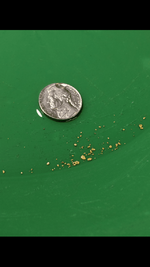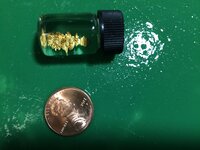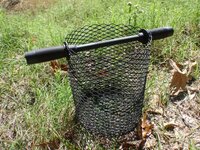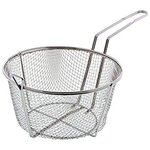Keeneongold
Jr. Member
- Aug 11, 2017
- 56
- 41
- Detector(s) used
- Keene a52 with high/low flow gold hog mats.
11in. fry basket
5 gallon soy sauce buckets
- Primary Interest:
- Prospecting
In S.w. Ohio and found a new place.
Research some surficial maps and picked a spot.
Drove around and saw a land owner out burning trash and asked for permission.
"Gold in that creek?"
"Yes sir"
"Pull around and park by the fuel tank"
"YES"!
We walked to the nearest turn in the creek and found 2 foot round rocks scattered here and there on top of the gravel bar. Front end of the bar is cobble, back end is sand.
Went to stick a shovel in to sample pan and the stuff is packed hard.
At least 4 to 5 minutes to fill up a classifier to do one sample pan.
1st sample pan gives us 3 of the biggest flakes I've ever seen without shelling out money for paydirt.
I was using a #12 classifier. I could have never conceived that I would find anything bigger where I'm at.
Well we do a little dance and do 2 more pans. We're just there to check it out and it's getting dark.
Point is this.... Last Wednesday we spent about 5 hours in other parts of the creek sampling and investigating and ended up back at the down stream place wher we first sampled.
The very top (6inches) is HARD packed. Below that is kinda soft clay and seemingly decomposing shale type bedrock...even though the map says the native bedrock is several hundreds of feet below us.
The stuff we're dealing with is, I think, a very unmolested layer of glacial deposit. I'm not sure what accounts for this cobble bar being so hard packed but it is. At one point we were digging and I saw about 5 or six flattish stones horizontally packed in with one flat semi triangular stone vertically wedged in perfectly between. It looked like a stone mason with a sense of humor layed a wall on the side of this river bank.
Where I need help is this... we will keep excavating this layer no doubt but I fear when we leave it, come spring the flood waters will bring stones down the creek and break up a previously impenetrable hardpack, thus throwing all our big gold into places unknown. I know where it is now. If we had found this place at the beginning of summer we could have got "all" of the big stuff on the surface.
How do we protect this bar?
Should we jam our holes with holders?
Is there anything we can do to ward off the erosion that springtime floods will bring.
Also, any ideas of what's happening in this creek is appreciated.
Research some surficial maps and picked a spot.
Drove around and saw a land owner out burning trash and asked for permission.
"Gold in that creek?"
"Yes sir"
"Pull around and park by the fuel tank"
"YES"!
We walked to the nearest turn in the creek and found 2 foot round rocks scattered here and there on top of the gravel bar. Front end of the bar is cobble, back end is sand.
Went to stick a shovel in to sample pan and the stuff is packed hard.
At least 4 to 5 minutes to fill up a classifier to do one sample pan.
1st sample pan gives us 3 of the biggest flakes I've ever seen without shelling out money for paydirt.
I was using a #12 classifier. I could have never conceived that I would find anything bigger where I'm at.
Well we do a little dance and do 2 more pans. We're just there to check it out and it's getting dark.
Point is this.... Last Wednesday we spent about 5 hours in other parts of the creek sampling and investigating and ended up back at the down stream place wher we first sampled.
The very top (6inches) is HARD packed. Below that is kinda soft clay and seemingly decomposing shale type bedrock...even though the map says the native bedrock is several hundreds of feet below us.
The stuff we're dealing with is, I think, a very unmolested layer of glacial deposit. I'm not sure what accounts for this cobble bar being so hard packed but it is. At one point we were digging and I saw about 5 or six flattish stones horizontally packed in with one flat semi triangular stone vertically wedged in perfectly between. It looked like a stone mason with a sense of humor layed a wall on the side of this river bank.
Where I need help is this... we will keep excavating this layer no doubt but I fear when we leave it, come spring the flood waters will bring stones down the creek and break up a previously impenetrable hardpack, thus throwing all our big gold into places unknown. I know where it is now. If we had found this place at the beginning of summer we could have got "all" of the big stuff on the surface.
How do we protect this bar?
Should we jam our holes with holders?
Is there anything we can do to ward off the erosion that springtime floods will bring.
Also, any ideas of what's happening in this creek is appreciated.
Upvote
0










